Birds eating dead animals sounds a bit gross, right?! That’s exactly what we thought at first! But we invite you to look at this from another perspective – these birds are actually doing other animals and humans a favor, as they prevent toxins and bacteria from spreading.
As such, today you’ll learn about 11 types of birds that have been observed scavenging the carcasses of dead animals. Keep reading to discover some jaw-dropping details about them!
11 Carrion Birds That Eat Dead Animals
Halfway through this list, you’ll probably notice you’ve already suspected that these birds feed on dead animals. The most noticeable hint is their appearance – they seem to have something in common, right?! They’re large birds with noticeable beaks that look almost intimidating!
Moreover, most are bold and aggressive creatures that won’t turn away from stealing carcasses from other predators!
1. Vultures
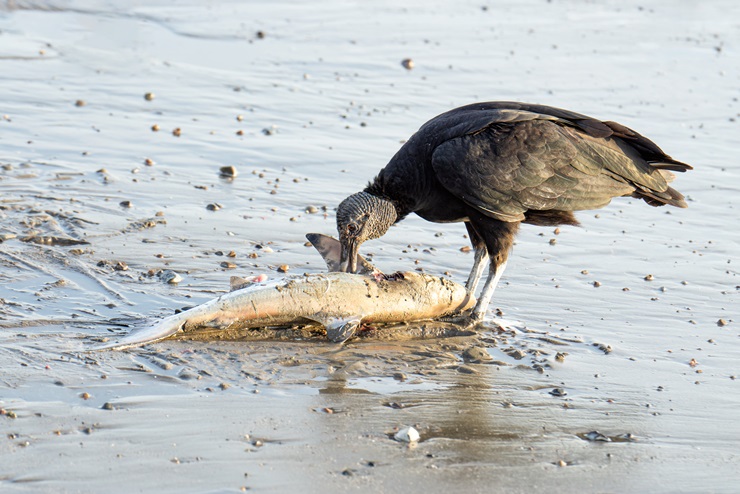
What better way to start our list than by mentioning the famous carrion scavengers – the vultures! The term “vulture” is used in regard to 23 species, which include condors as well. They are widespread around the world and usually divided into two groups – Old World vultures (Europe, Asia, and Africa) and New World vultures (North and South America).
These birds of prey are known primarily for being scavengers that rarely hunt healthy, living animals. Instead, they’ll hunt down every dead or wounded animal in the area. It’s even believed they’re intelligent enough to watch predators kill their prey, wait until they’re gone, then proceed with eating whatever’s left of the dead animal.
If you think that’s gross, we’ll tell you otherwise because these creatures are doing the world a big favor! Thanks to their corrosive stomach acid, vultures can easily digest carcasses infected with different types of deadly toxins, like hog cholera bacteria or botulinum toxin.
Other scavengers stand no chance against these toxins. Vultures, on the other hand, help the environment by removing the risk of bacterium spread.
A species worth mentioning in this section is the Andean condor, which is, in fact, a vulture, as its scientific name suggests – Vultur gryphus. Like other vultures, this species feeds primarily on carrion, preferring carcasses of large animals like deer and cattle. It’s known to travel more than 200 kilometers daily in search of dead animals!
2. Hawks
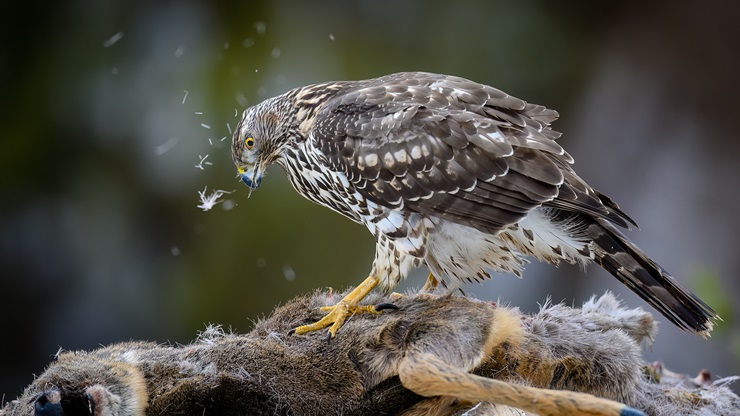
Like vultures, hawks are part of the Accipitridae family and are spread worldwide, except in Antarctica. The term “hawk” is used for members of the Accipitrinae subfamily and the Buteo group, although the Buteo species are often called buzzards in some parts of the world.
However, unlike vultures, hawks aren’t obligate scavengers. They primarily feed on live prey like snakes, fish, lizards, mice, and other birds. However, if the opportunity arises, hawks won’t refuse a carrion meal.
The red-tailed hawk, for example, is one of the few animal species with such a diverse diet. It is believed that the red-tailed hawk preys on nearly 500 different species! Besides live prey, it has been seen scavenging dead animals like Virginia opossums, domestic cats, common raccoons, and red foxes.
The same goes for the Northern goshawk. These birds usually prey on smaller animals but may scavenge the carcasses of larger prey like deer or sheep. This has been observed especially in regions with harsh winters when food is scarce.
3. Crested Caracaras
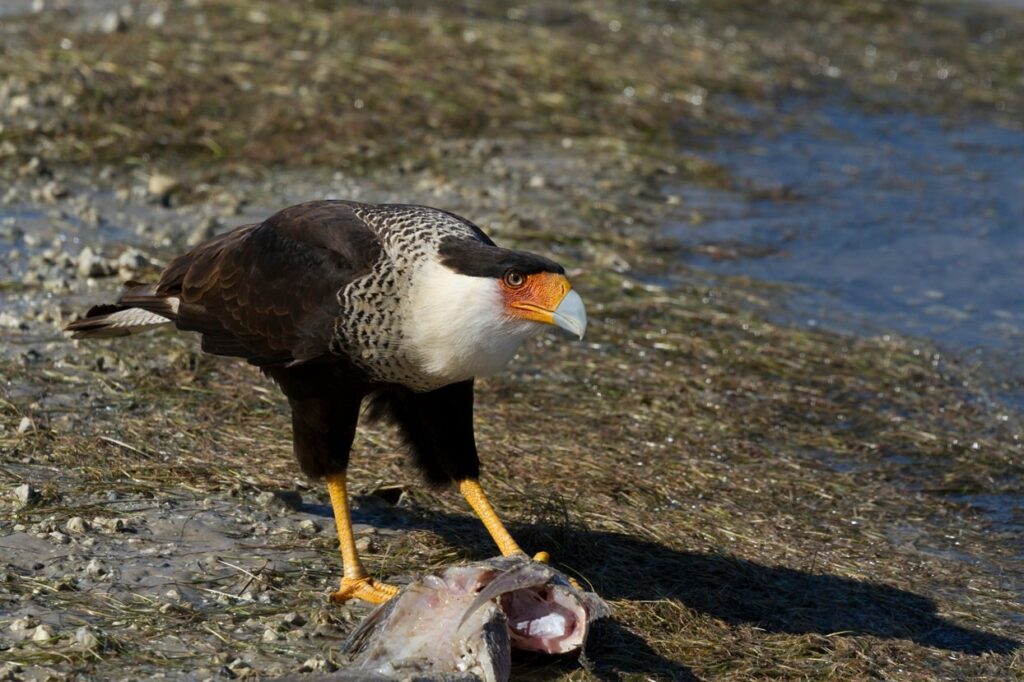
The crested caracara is the only extant Caracara species. It is a bird of prey living in Central and South America, although it has been spotted in the United States as well. Breeding occurs in spring and summer, and their nests are built on top of tall palms or other trees, although some individuals may leave their nests on the ground.
These birds of prey are opportunistic hunters. They primarily feed on carrion and are considered superior at taking carcasses compared to black and turkey vultures. They’re known to prey on live animals as well.
In fact, crested caracaras have been observed stealing prey from other raptors and raiding reptile and bird nests to get what they want! As such, they’re definitely bold hunters and don’t stop until they get their meal!
Besides carrion, crested caracaras are known to eat small mammals and birds, amphibians, fish, reptiles, crabs, worms, and occasionally fruit.
4. Eagles

As hawks and vultures, eagles are part of the Accipitridae family. This common name is used for roughly 68 species spread throughout Eurasia, Africa, Australia, and the Americas. By far the most known species is the bald eagle, but many others are worth mentioning, such as the booted eagle, the black-chested buzzard-eagle, or the crowned eagle, to name a few.
These species are typically grouped depending on their diet (fish eagles, snake eagles, etc), although this doesn’t mean they are restricted to that specific type of prey. Many of them are known to prey on carrion besides the typical preferred live prey.
The bald eagle, for instance, is very fond of carrion. It’s known to hunt in open forests that provide regular access to dead animals. It has been observed feeding on dead animals as large as whales!
These bold creatures are also known to engage in kleptoparasitism, meaning they steal prey from other predators. They may attack dogs, vultures, or gulls at their feeding sites, forcing them to give up their food.
Other species, like the crowned eagle, only rarely feed on carrion and prefer live prey.
5. Crows
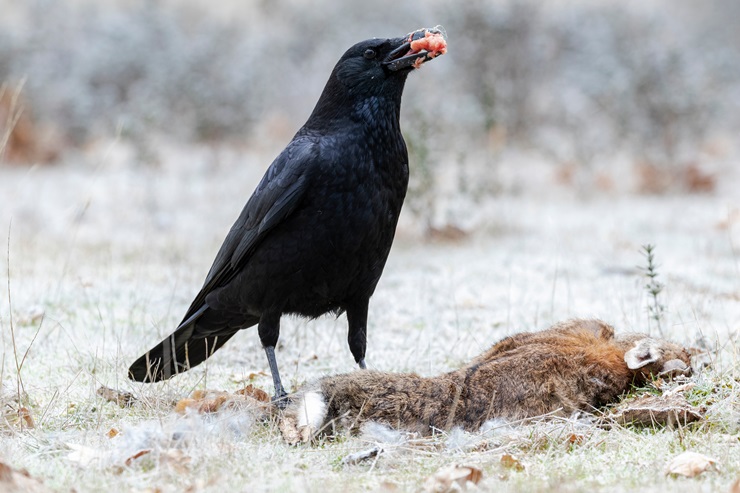
The common name crow is nowadays used for several species in the Corvus genus. They’re probably the world’s most infamous birds because of their tendency to destroy gardens and scare small birds away from backyard feeders, thus stealing their food. They’re also well-known for checking out garbage cans, so the fact that they won’t refuse a carrion meal shouldn’t be a surprise.
The American crow is only one of the crow species that feed on carrion. Besides dead animals, they’ll take whatever they find – invertebrates, scraps of human food, nuts, fruits, seeds, eggs, fish, and mammals.
The carrion crow, on the other hand, feeds primarily on carrion, as its common name suggests. It will accept any type of carrion it stumbles upon. However, like its American relative, the carrion crow will eat insects, seeds, nuts, fruits, amphibians, fish, and mammals – in short, anything it stumbles upon, which is why they’re infamous among homeowners and gardeners.
6. Gulls
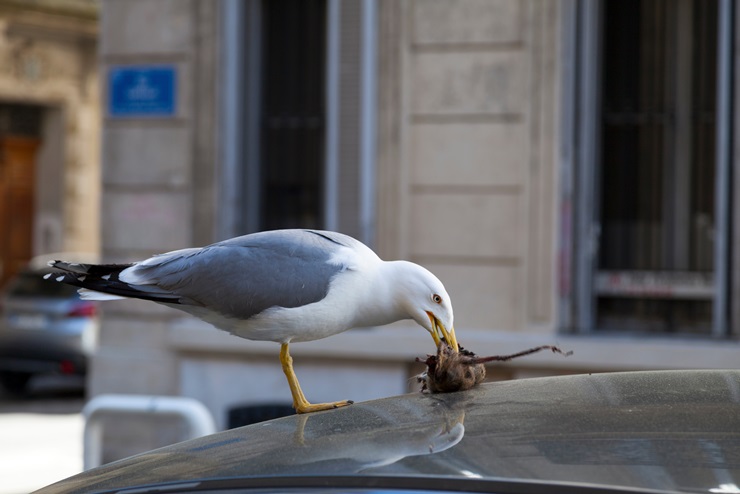
Gulls are part of the Laridae family. They are spread worldwide, breeding on every continent, but being less common on tropical islands. Many species are migratory and travel long distances to reach their breeding grounds.
Like crows, gulls are opportunistic feeders and will fight hard for their food. They eat almost anything they consider edible. During the breeding season, gulls prefer eating fruit, seeds, and earthworms.
Outside the breeding season, these seabirds switch to marine prey, as they spend more time above the water. Naturally, they have been observed feeding on carrion, as well. After all, nothing’s out of their reach, right?!
7. Skuas

Skuas are predatory birds in the Stercorariidae family. There are seven species of skuas spread around the world. Many of them breed along the coast of Antarctica, as they’re long-distance migrants.
Their diet depends on whether it’s breeding or non-breeding season. If it’s the latter, skuas eat primarily fish but also feed on carrion and offal (internal organs of an animal).
Most skuas obtain their food through kleptoparasitism, a behavior through which they bully other animals into giving up on their prey. They’re pretty aggressive and bold, so it’s only natural they rely on kleptoparasitism to obtain food.
Skuas usually chase down terns, gulls, and other seabirds alike and steal their prey. They’ve been observed feeding on the carcasses of penguins and pinnipeds.
8. Marabou Storks
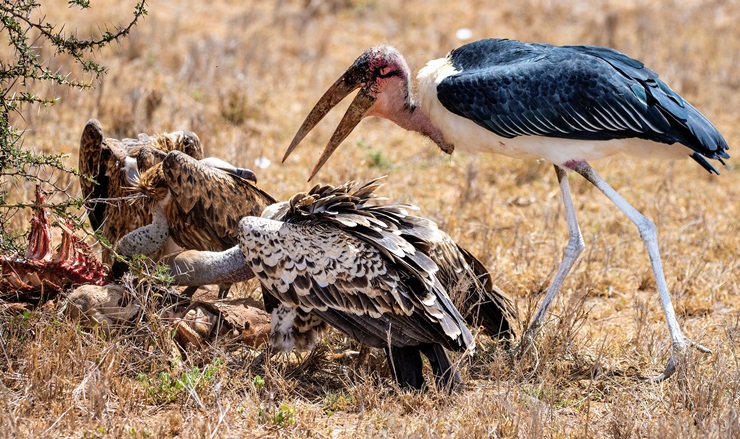
The marabou stork is part of the Ciconiidae family of wading birds with long bills, necks, and legs. These birds are widely distributed throughout sub-Saharan Africa, being found both in urban and rural areas. They’ve been observed especially near landfill sites, which indicates they’re scavengers.
Moreover, since they mainly eat carrion, marabou storks often feed alongside vultures or at least follow them to find food. They’re even bold enough to steal pieces of dead meat from vultures while they are scavenging a carcass!
Besides carrion, marabou storks eat food scraps and even feces! They also feed on other birds like doves, pelicans, and pigeons and will occasionally take fish, frogs, lizards, insects, and snakes.
9. Sheathbills
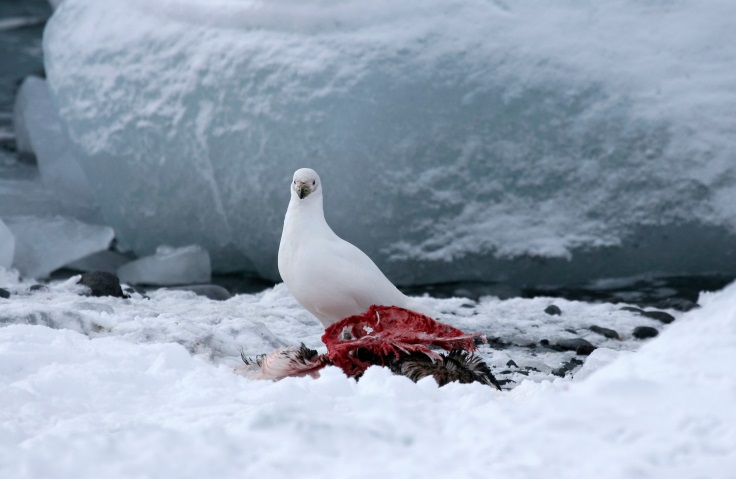
Sheathbills form the Chionis genus of seabirds and are the only endemic breeders of the Antarctic region. They’ve been observed breeding alongside penguin colonies and stealing the krill adult penguins regurgitate for their babies. Sometimes they may even eat the penguin babies.
If they come near human settlements, sheathbills feed on offal. Carrion, feces, and human waste are also important food sources. They’re even known to eat stillborn seal pups!
Like other birds on our list, sheathbills are opportunistic scavengers and bold enough to steal what they want from other predators!
10. Ospreys
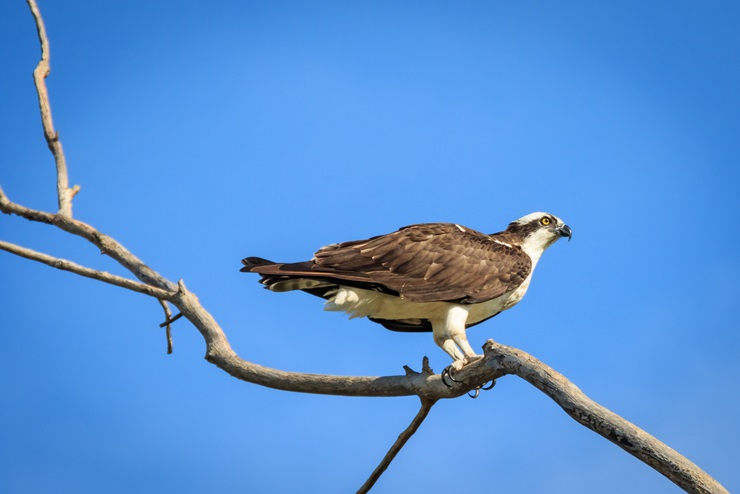
The osprey is scientifically called Pandion haliaetus. It is often commonly called the seahawk or fish hawk. Since these birds can adapt to various weather and environmental conditions, they’re found in diverse habitats, although they nest primarily near water sources.
These large birds of prey feed primarily on live fish. If opportunity arises or fish is scarce, the osprey will eat hares, rabbits, rodents, snakes, frogs, birds, and salamanders, to name a few. Unlike other birds on our list, the osprey rarely eats carrion, but it was observed feeding on dead or dying fish, dead Virginia opossums, and dead white-tailed deer.
11. Owls
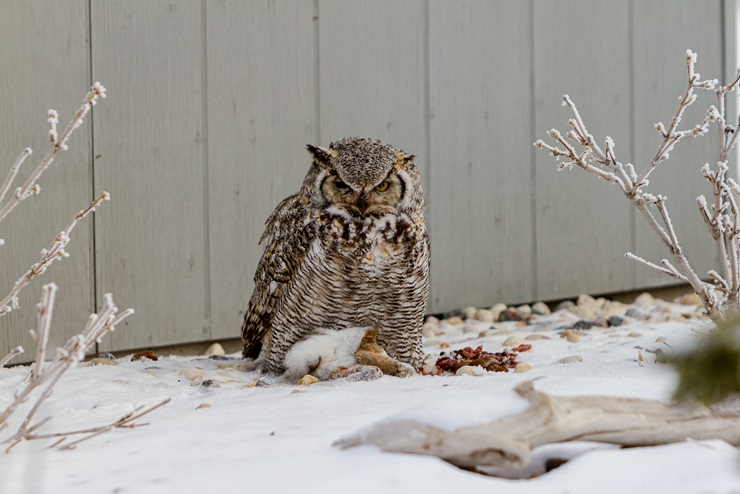
Owls form the Strigiformes order of solitary, nocturnal birds. However, some species are diurnal or crepuscular. They’re known for having sharp talons, camouflaging feathers, and excellent eyesight and hearing.
Needless to say, these traits make owls excellent hunters! Although they primarily prey on small mammals, birds, fish, and insects, some species have been observed delighting in carrion meals.
This behavior has been previously thought to be very rare in owls. Nowadays, on the other hand, more and more people catch owls eating carrion on camera, thus revolutionizing what we’ve known about their diet.
Take the great horned owl. The individuals wintering in Canada or other northern regions were often seen scavenging animal carcasses, especially during very harsh winters. One specimen was observed scavenging the carcass of a white-tailed deer.
The snowy owl is another species seen to feed on carrion. It was observed scavenging reindeer, walrus, and whale carcasses. Feeding on carrion is especially common outside the breeding season.
